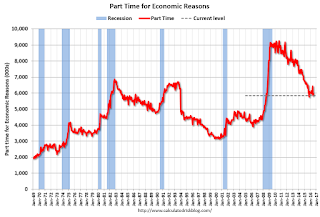by Calculated Risk on 8/05/2016 10:01:00 AM
Friday, August 05, 2016
Employment Comments: Another Strong Report
The headline jobs number was strong, and there were upward revisions to job growth for prior months. Both the participation rate and employment-population ratio ticked up, and wages increased.
A few negatives were U-6 increased slightly, and the number of both long term unemployed and part time workers increased slightly. But overall this was a strong report.
Earlier: July Employment Report: 255,000 Jobs, 4.9% Unemployment Rate
In July, the year-over-year change was 2.45 million jobs.
Average Hourly Earnings

The graph shows the nominal year-over-year change in "Average Hourly Earnings" for all private employees. Nominal wage growth was at 2.6% YoY in July. This series is noisy, however overall wage growth is trending up.
Note: CPI has been running around 2%, so there has been real wage growth.
Part Time for Economic Reasons

The number of persons employed part time for economic reasons (sometimes referred to as involuntary part-time workers) was little changed at 5.9 million in July. These individuals, who would have preferred full-time employment, were working part time because their hours had been cut back or because they were unable to find a full-time job.The number of persons working part time for economic reasons increased slightly in July. This level suggests slack still in the labor market.
These workers are included in the alternate measure of labor underutilization (U-6) that increased to 9.7% in July.
Unemployed over 26 Weeks
 This graph shows the number of workers unemployed for 27 weeks or more.
This graph shows the number of workers unemployed for 27 weeks or more. According to the BLS, there are 2.020 million workers who have been unemployed for more than 26 weeks and still want a job. This was up slightly from 1.979 million in June.
This is generally trending down, but is still high.
There are still signs of slack (as example, elevated level of part time workers for economic reasons and U-6), but there also signs the labor market is tightening.
Overall this was a strong report. Job growth averaged 274,000 over the last two months, and 186,000 per month this year.


